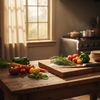Offset Design Kitchen Scissors For Comfort Guide
Key Takeaways
- Traditional straight-blade kitchen scissors often cause discomfort and awkward wrist angles during use.
- Offset design kitchen scissors are specifically created to enhance user comfort.
- The offset design helps prevent knuckle scraping on surfaces while cutting.
- Using offset design scissors can reduce hand cramps during prolonged kitchen tasks.
- The offset design represents a significant improvement in ergonomic kitchen tool design.
Table of Contents
- Why Your Hands Deserve Better: The Offset Design Revolution
- The Anatomy of Comfort: How Offset Design Works
- Essential Comfort Features That Actually Matter
- Materials That Make the Difference
- Detachable Blades: The Hygiene Game-Changer
- Matching Scissors to Your Kitchen Style
- DI ORO: Setting the Comfort Standard
- Offset vs. Straight Blade: The Comfort Showdown
- Game-Changing Kitchen Scenarios
- Mastering Your Offset Scissors Technique
- Your Perfect Pair Selection Guide
- Your Comfort Upgrade Checklist
- Why DI ORO Sets the Offset Comfort Standard
- Solving Common Offset Scissors Challenges
- The Future of Kitchen Comfort Technology
Why Your Hands Deserve Better: The Offset Design Revolution
Ever tried spatchcocking a chicken only to have your knuckles scraping the cutting board with every snip? Or found yourself cramping up halfway through trimming herbs because your scissors force your wrist into an awkward angle? Traditional straight-blade kitchen scissors weren't designed with your comfort in mind, but offset design kitchen scissors for comfort are changing the game entirely.
Offset design kitchen scissors feature handles positioned above the blade level, creating crucial clearance between your hand and the work surface. This isn't just about convenience, it's about transforming kitchen prep from a strain-inducing chore into the smooth, controlled experience it should be. High-carbon stainless steel offset kitchen scissors are an excellent choice for anyone seeking maximum comfort and performance in daily food prep.
For those who want even more versatility, a 2-piece stainless steel kitchen scissor set ensures you always have the right tool for every kitchen task, from heavy-duty cutting to delicate snipping.
The Anatomy of Comfort: How Offset Design Works

The offset in these scissors refers to the vertical displacement between the cutting blades and handle grips, typically 15-20mm of clearance that keeps your fingers elevated above the work surface. Unlike straight scissors where your knuckles inevitably drag across cutting boards, offset scissors maintain natural hand positioning throughout the cutting motion.
This design reduces median nerve compression (a key factor in carpal tunnel syndrome) by maintaining neutral wrist alignment. The elevated handle position also engages larger muscle groups in your forearm rather than relying solely on finger strength, distributing cutting force more efficiently and reducing fatigue during extended use.
When trimming poultry or snipping delicate herbs directly over a pan, the offset design provides an unobstructed view of your cutting line while maintaining precise control, something impossible with traditional straight-blade scissors.
Essential Comfort Features That Actually Matter
The most critical comfort feature is proper offset alignment, look for at least 15mm clearance between blade and handle centerlines. This measurement ensures adequate knuckle clearance for most hand sizes while maintaining cutting efficiency.
Ergonomic grip design should include textured, non-slip surfaces and finger channels that guide natural hand placement. Pro-grade silicone handles (forever-chemical free) provide superior grip even when wet, while cushioned thumb and finger rests prevent pressure points during repetitive cutting.
Spring-loaded action reduces the effort required to reopen scissors between cuts, preventing hand fatigue during extended prep sessions. Quality offset scissors should operate smoothly with minimal resistance, requiring approximately 2-3 pounds of closing force for clean cuts through chicken skin or thick herb stems.
Materials That Make the Difference
High-carbon surgical stainless steel blades maintain sharp edges longer while resisting corrosion and food acids. The weight distribution matters too, quality offset scissors typically weigh 4-6 ounces, providing substantial feel without causing hand strain.
Handle materials directly impact comfort during extended use. Forever-chemical-free silicone grips offer superior tactile feedback and remain comfortable even during long prep sessions, unlike hard plastic handles that can cause pressure points and slipping.
| Material Feature | Comfort Impact | Durability Benefit |
|---|---|---|
| Surgical Stainless Steel | Consistent cutting force | Maintains edge sharpness |
| Pro-Grade Silicone Handles | Non-slip grip, pressure distribution | Heat resistant to 600°F |
| Precision Pivot Points | Smooth action, reduced effort | Maintains alignment over time |
For more details on blade materials and their impact on kitchen performance, see this sharp stainless steel kitchen scissors guide.
Detachable Blades: The Hygiene Game-Changer

Detachable blade systems allow complete separation of cutting surfaces for thorough cleaning, crucial when switching between raw proteins and fresh ingredients. The separation mechanism should operate with a simple twist or slide action, requiring no tools while maintaining secure blade alignment during use.
This feature eliminates the hidden food debris that accumulates in traditional scissor joints, preventing bacterial growth and cross-contamination. After separating blades, both pieces can go directly into the dishwasher or be hand-washed with complete access to all surfaces.
Quality detachable systems include alignment guides that ensure proper blade positioning when reassembling, maintaining the precise cutting edge relationship essential for clean cuts.
Matching Scissors to Your Kitchen Style
Your primary cutting tasks should drive your selection. Heavy-duty food prep requires robust 9-inch models with substantial blade thickness, while precision herb work benefits from lighter 7-inch versions with finer blade profiles.
Hand Size and Grip Compatibility
Measure your hand span from thumb tip to pinky tip, spans under 7 inches work best with compact handle designs, while spans over 8 inches need full-size grips to prevent cramping. The finger holes should accommodate your digits without pinching or excessive looseness.
Test the spring tension if possible, the scissors should reopen automatically but not with such force that they feel bouncy or uncontrolled. Optimal tension provides gentle assistance without fighting your natural cutting rhythm.
DI ORO: Setting the Comfort Standard
DI ORO's offset design kitchen scissors combine award-winning engineering with uncompromising comfort standards. Our 9-inch professional model features surgical-grade stainless steel blades with precision-ground edges, paired with forever-chemical-free silicone handles that maintain grip even during extended prep sessions.
The detachable blade system earned recognition from America's Test Kitchen for its intuitive operation and thorough cleaning capability. With 18mm of offset clearance and ergonomically contoured finger channels, these scissors eliminate the hand strain that makes kitchen prep feel like work.
DI ORO Advantage: Our Forever Warranty backs every pair because we engineer for performance that lasts. When comfort meets professional-grade construction, cooking becomes the joy it should be.
Discover more about our award winning kitchen utensils that bring professional quality to your home kitchen.
Offset vs. Straight Blade: The Comfort Showdown

The fundamental difference lies in hand positioning and cutting mechanics. Offset design kitchen scissors for comfort maintain natural wrist alignment while providing superior leverage, whereas straight-blade scissors force your hand into compromised positions that increase strain over time.
| Feature | Offset Design | Straight Blade |
|---|---|---|
| Knuckle Clearance | 15-20mm elevation prevents scraping | Direct contact with cutting surface |
| Wrist Position | Neutral alignment reduces strain | Angled positioning causes fatigue |
| Cutting Leverage | Enhanced mechanical advantage | Limited by handle position |
| Precision Control | Clear sight lines to cutting point | Hand blocks visual reference |
Straight scissors remain useful for craft projects and occasional light tasks, but for regular kitchen use, especially when comfort matters, offset design delivers measurable advantages in both performance and ergonomics.
Game-Changing Kitchen Scenarios
Spatchcocking a whole chicken becomes effortless with offset scissors, the elevated handles provide clear access to the backbone while maintaining cutting power through tough cartilage. Traditional scissors would have your knuckles grinding against the cutting board with every snip.
When trimming fat from steaks or preparing herb garnishes directly over serving plates, the offset design prevents awkward wrist angles that lead to imprecise cuts and hand cramping. The elevated position provides restaurant-quality control for home chefs tackling ambitious recipes.
Opening stubborn food packaging transforms from a wrestling match into smooth, controlled cuts. The improved leverage means less grip strength required, while the comfortable hand position prevents the white-knuckle tension that makes simple tasks feel like battles.
Customer Insight: "After 20 minutes of holiday prep with my old scissors, my hands would ache. With DI ORO's offset design, I prepped for three hours straight without discomfort." - Verified buyer review
For more real-world tips and inspiration, check out this kitchen scissors article on our blog.
Mastering Your Offset Scissors Technique
Proper grip utilizes the natural curve of your fingers, thumb through the lower loop, middle finger through the upper loop, with your index finger providing guidance along the blade spine. This positioning maximizes the ergonomic benefits while maintaining precise control.
For heavy cutting tasks like spatchcocking, use short, deliberate strokes rather than attempting to power through in single cuts. The offset design provides excellent leverage, but technique trumps force every time. Keep blades perpendicular to your cutting line for clean results.
Safety protocols remain crucial: always engage blade locks when storing, clean immediately after use with raw proteins, and store in a way that protects both the cutting edges and your fingers when reaching into drawers.
Your Perfect Pair Selection Guide

Start by evaluating your most frequent cutting tasks. Heavy-duty prep work demands 9-inch models with substantial blade thickness, while precision tasks benefit from lighter 7-8 inch versions. The blade material should be surgical-grade stainless steel for food safety and edge retention.
Handle comfort varies significantly between brands. Look for scissors for kitchen use with cushioned grips, textured surfaces for secure hold, and finger channels that guide natural placement. The detachable blade feature isn't optional, it's essential for proper hygiene and maintenance.
Test the action if possible. Quality offset design kitchen scissors for comfort should operate smoothly with minimal effort, reopening automatically without excessive spring tension. The pivot point should feel solid and precise, not loose or wobbly.
Pro Selection Tip: The best kitchen scissors feel like natural extensions of your hand. If you're consciously thinking about grip or hand position while cutting, keep looking.
If you need a multi-purpose option, consider these high-carbon stainless steel multi-purpose kitchen scissors for all-around kitchen utility.
Your Comfort Upgrade Checklist
Before making your investment in offset design kitchen scissors for comfort, verify these essential features: minimum 15mm offset clearance, forever-chemical-free handle materials, detachable blade system for thorough cleaning, and surgical-grade stainless steel construction.
Consider the warranty coverage, quality manufacturers back their engineering with comprehensive protection. DI ORO's Forever Warranty reflects our confidence in creating tools that transform kitchen prep from strain-inducing work into the comfortable, controlled experience every home chef deserves.
Ready to upgrade your kitchen comfort? Your hands will thank you with every perfectly executed cut. For more on ergonomic tool design, see this ergonomic scissors guide.
Why DI ORO Sets the Offset Comfort Standard
DI ORO's 9-inch offset kitchen scissors represent the pinnacle of ergonomic engineering for home chefs who refuse to compromise. Our surgical-grade stainless steel blades maintain razor-sharp precision through thousands of cuts, while the forever-chemical-free silicone handles provide the secure, comfortable grip that transforms marathon prep sessions from endurance tests into enjoyable culinary adventures.
The America's Test Kitchen recognition isn't just an award, it's validation that our offset design kitchen scissors for comfort deliver measurable performance advantages. The 18mm offset clearance eliminates knuckle contact entirely, while the detachable blade system ensures thorough cleaning that meets professional kitchen standards.
What truly sets DI ORO apart is our Forever Warranty commitment. We engineer these scissors to last decades, not seasons, because we believe exceptional tools should be lifetime investments in your culinary creativity.
DI ORO Advantage: The only offset kitchen scissors backed by America's Test Kitchen testing, Food Network recognition, and a Forever Warranty that guarantees your comfort investment.
Explore more kitchen essentials in our Cut & Peel collection for a complete upgrade.
Solving Common Offset Scissors Challenges

Stiff operation typically results from food residue in the pivot mechanism. Disassemble the blades, clean thoroughly with warm soapy water, and apply a single drop of food-grade mineral oil to the pivot point. Proper maintenance prevents this issue entirely.
Blade misalignment after cleaning occurs when users force reassembly. The key is gentle pressure while ensuring the locking mechanism engages completely, you'll hear a subtle click when properly seated. Never force misaligned blades, as this damages the precision-engineered tolerances.
Left-handed users often struggle with scissors designed for right-handed cutting angles. Quality offset design kitchen scissors for comfort feature ambidextrous blade geometry that accommodates both orientations without compromising cutting efficiency.
Rust prevention requires immediate cleaning after contact with acidic foods like tomatoes or citrus. Even surgical-grade stainless steel benefits from thorough drying before storage, moisture trapped in handle crevices creates oxidation over time. For more on multi-purpose scissor care and versatility, see our multi purpose high carbon kitchen scissors blog post.
The Future of Kitchen Comfort Technology
Emerging ergonomic innovations focus on adaptive handle materials that respond to grip pressure, reducing hand fatigue during extended use. Smart pivot systems with variable tension settings will soon allow users to customize cutting resistance for different tasks and hand strengths.
Antimicrobial surface treatments are becoming standard in professional-grade kitchen tools, providing additional food safety benefits beyond traditional cleaning protocols. These advances complement the fundamental comfort advantages that make offset design kitchen scissors for comfort essential for serious home chefs.
The integration of precision manufacturing with ergonomic science continues advancing, but the core principles remain unchanged: proper hand positioning, quality materials, and thoughtful design create tools that enhance rather than hinder culinary creativity.
Your investment in comfort-focused kitchen tools pays dividends with every meal preparation. Choose scissors that work with your body's natural mechanics, not against them, and discover how proper ergonomics transforms cooking from chore into craft. For a broader overview of scissors and their history, visit this Wikipedia article on scissors.
Frequently Asked Questions
How does the offset design in kitchen scissors improve comfort compared to traditional straight-blade scissors?
The offset design elevates the handles above the blades, preventing your knuckles from scraping the cutting surface. This adjustment reduces awkward wrist angles common with straight-blade scissors, making cutting tasks more comfortable and less fatiguing.
What specific ergonomic benefits does the offset design provide to reduce hand cramps and wrist strain?
By positioning the handles higher than the blades, offset scissors promote a more natural wrist alignment and reduce pressure points on your hand. This ergonomic setup minimizes hand cramps and wrist strain during prolonged use, turning tough kitchen prep into a smoother experience.
Why is proper offset alignment important, and what clearance should I look for when choosing offset kitchen scissors?
Proper offset alignment ensures your fingers stay clear of the cutting surface, preventing knuckle scraping and discomfort. Look for scissors with about 15-20mm of vertical clearance between the handles and blades for optimal comfort and control.
How do offset design kitchen scissors enhance precision and control during various kitchen tasks like trimming poultry or herbs?
The elevated handle position offers better leverage and visibility, allowing for more precise, controlled cuts. This design makes tasks like trimming poultry or snipping herbs easier and more accurate, reducing slip and improving overall cutting performance.




